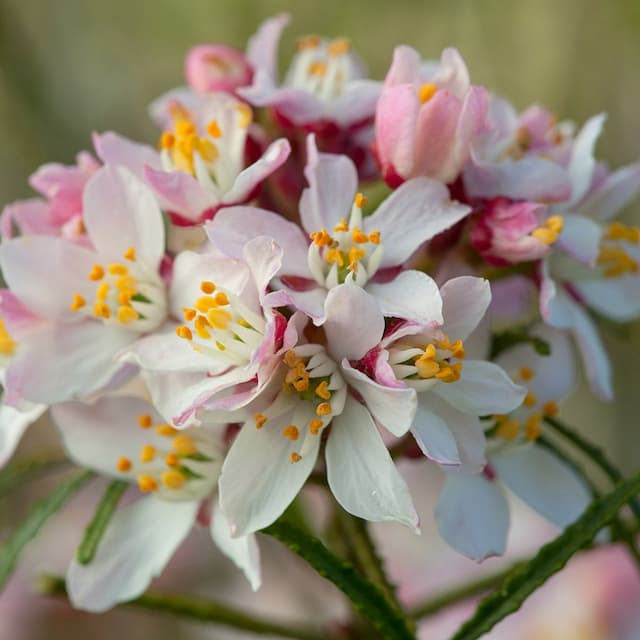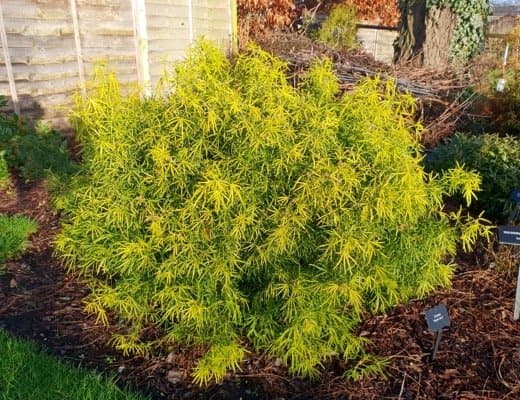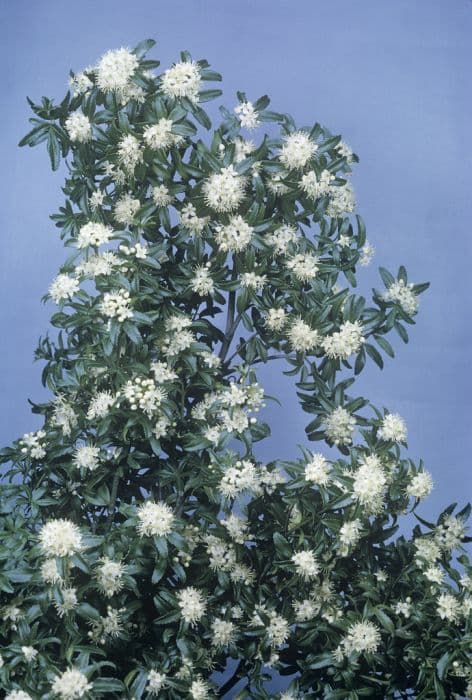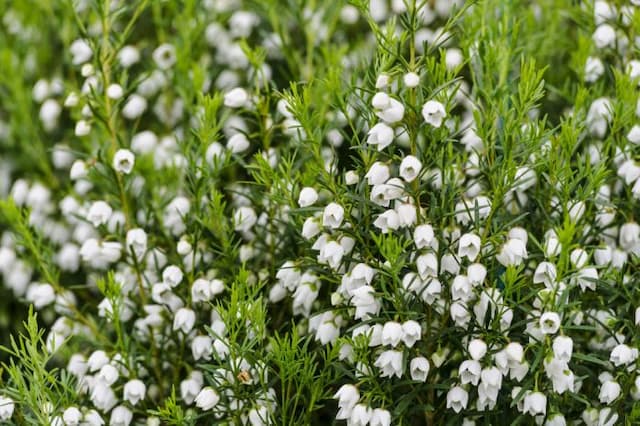Breath of Heaven Coleonema pulchellum
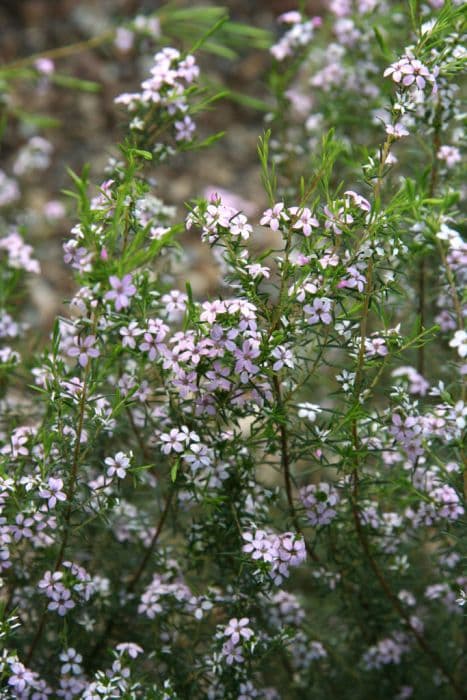
ABOUT
Commonly known as the confetti bush, this eye-catching plant is notable for its fine, needle-like leaves that create a feathery, airy appearance. The leaves are small and aromatic, often a bright green color that can add a lively touch to any garden setting. When in bloom, the confetti bush displays a profusion of small, star-shaped flowers that range in color from pink to pale purple, giving the impression of a sprinkle of confetti over the foliage. These delicate blossoms can be quite abundant, covering the plant in a blanket of color and contributing to its ornamental appeal. The combination of its fragrant leaves and attractive flowers makes it a popular choice for gardeners looking to add texture and subtle hues to their landscapes.
About this plant
 Names
NamesFamily
Rutaceae
Synonyms
Breath of Heaven, Pink Diosma
Common names
Coleonema pulchrum, Diosma pulchella, Coleonema album, Coleonema nubigenum, Coleonema calycinum, Coleonema virgatum, Coleonema gracile, Coleonema parviflorum.
 Toxicity
ToxicityTo humans
Coleonema pulchellum, commonly known as confetti bush, is not widely reported to be toxic to humans. However, as with many plants, individuals may experience varying degrees of sensitivity, and it's always wise to exercise caution and avoid ingesting plants not known to be edible. If you suspect poisoning from any plant, seek medical attention promptly.
To pets
The confetti bush (Coleonema pulchellum) is not known to be highly toxic to pets. However, ingestion of plant material can sometimes lead to gastrointestinal upset in animals, such as vomiting or diarrhea, due to the irritation of the digestive tract. If you notice such symptoms after your pet has ingested part of this plant, it is recommended to consult a veterinarian.
 Characteristics
CharacteristicsLife cycle
Perennials
Foliage type
Evergreen
Color of leaves
Green
Flower color
Pink
Height
5 feet (1.5 meters)
Spread
5 feet (1.5 meters)
Plant type
Shrub
Hardiness zones
8
Native area
South Africa
Benefits
 General Benefits
General Benefits- Ornamental use: Coleonema pulchellum, commonly known as the confetti bush, is often used for its ornamental value due to its fine, needle-like leaves and delicate pink or white flowers that can enhance the aesthetic of gardens and landscapes.
- Fragrance: The confetti bush releases a pleasant, spicy fragrance when its leaves are brushed against or crushed, which can add a delightful scent to gardens and outdoor spaces.
- Erosion control: Its dense growth habit makes it useful for stabilizing soil and controlling erosion on slopes and banks.
- Drought tolerance: As a plant native to South Africa, the confetti bush is adapted to dry conditions, making it suitable for water-wise gardens and xeriscaping in suitable climates.
- Bee and butterfly attraction: The blooms of Coleonema pulchellum can attract pollinators such as bees and butterflies, supporting biodiversity in the garden.
- Low maintenance: The confetti bush is known for being easy to care for, requiring minimal maintenance once established, making it ideal for low-maintenance landscaping.
- Hedge and screen planting: With its dense growth, the confetti bush can be used to create informal hedges and screens for privacy or to define different areas within a garden.
- Culinary use: Some parts of confetti bush are used in cooking for their flavoring properties, although this is less common and not a primary benefit of the plant.
 Medical Properties
Medical Properties- This plant is not used for medical purposes.
 Air-purifying Qualities
Air-purifying QualitiesThis plant is not specifically known for air purifying qualities.
 Other Uses
Other Uses- Confetti Pink Breath of Heaven can be used as a natural dye, imparting a mild color to textiles or crafts.
- The fragrant leaves of the Pink Breath of Heaven are often incorporated into potpourris to add a pleasant aroma.
- Its small flowers can be used as edible garnishes for culinary dishes, assuming they haven't been treated with pesticides.
- The plant can be shaped into low hedges for landscaping, offering aesthetic borders in gardens.
- It has potential use in bonsai cultivation due to its fine leaves and the potential for intricate shaping.
- When planted en masse, Pink Breath of Heaven can be used for erosion control on slopes and banks.
- The essential oils from the leaves may be used in home-made natural insect repellents.
- It can be used as a windbreak in coastal areas where it is tolerant of windy conditions, to protect more sensitive plants.
- The dried branches and flowers can be fashioned into natural brooms or brush decorations.
- In artistic crafts, the fine foliage can be included in pressed flower arrangements or framed botanical art.
Interesting Facts
 Feng Shui
Feng ShuiThe Coleonema pulchellum, commonly known as the Breath of Heaven, is not used in Feng Shui practice.
 Zodiac Sign Compitability
Zodiac Sign CompitabilityThe Breath of Heaven is not used in astrology practice.
 Plant Symbolism
Plant Symbolism- Aesthetics and Beauty: The name "Coleonema pulchellum" itself has roots meaning 'beautiful' (pulchellum). This plant, commonly known as the 'Confetti Bush', is prized for its delicate, pretty flowers and pleasant scent, often symbolizing the appreciation of beauty.
- Resilience and Strength: As a plant native to South Africa, the Confetti Bush is adapted to harsh conditions, symbolizing the ability to endure and thrive in challenging environments.
- Fragrance and Purity: The Confetti Bush emits a pleasant fragrance, especially when its leaves are brushed against, often symbolizing purity, cleanliness, and the refreshing nature of its scent.
- Healing and Medicinal Properties: Traditionally, the Confetti Bush was used in herbal medicine by indigenous cultures. This symbolizes healing and the nurturing aspect of nature.
 Water
WaterThe Breath of Heaven (Coleonema pulchellum) should be watered regularly to keep the soil consistently moist but not waterlogged. During the active growing season in spring and summer, water the plant roughly once a week with about 1 gallon of water, depending on the size of the plant and the climate. Reduce watering frequency in fall and winter, aiming for every two to three weeks, as the plant requires less moisture during dormancy. It is crucial not to let the soil dry out completely, but also avoid overwatering, as this can lead to root rot.
 Light
LightBreath of Heaven thrives in full sun to partial shade. The ideal spot would be where the plant receives at least 6 hours of direct sunlight each day, but is also protected from the harsh afternoon sun, especially in hotter climates. Dappled shade can also be acceptable, ensuring the vibrant foliage remains healthy and the plant produces its characteristic pink flowers.
 Temperature
TemperatureBreath of Heaven prefers a mild climate and can tolerate a temperature range from about 20°F to 100°F. However, the ideal temperature for optimal growth is between 50°F and 70°F. It's important to protect the plant from frost, so in areas where temperatures drop below 20°F, providing some form of frost protection or moving it to a sheltered location is necessary.
 Pruning
PruningPruning the Breath of Heaven is necessary to maintain its shape, encourage fuller growth, and remove any dead or damaged branches. The best time to prune is in late winter or early spring before new growth begins. Prune lightly, up to one-third of the plant's size, and clean the cuts to promote healthy regrowth. Regular pruning also helps to rejuvenate older plants and keep them looking their best.
 Cleaning
CleaningAs needed
 Soil
SoilThe Breath of Heaven prefers well-draining, acidic to neutral soil with a pH of 5.0 to 7.0. A mix of two-thirds peat moss or acidic compost and one-third perlite or sand is ideal. Make sure to add some organic material to provide nutrients.
 Repotting
RepottingBreath of Heaven should be repotted every 2 to 3 years, or when it has outgrown its current container. It's essential to use a fresh soil mix when repotting to refresh the nutrients.
 Humidity & Misting
Humidity & MistingBreath of Heaven thrives in moderate to high humidity levels, around 50-70%. Avoid placing it in overly dry conditions which can cause leaf browning.
 Suitable locations
Suitable locationsIndoor
Place in bright, indirect light and ensure good air circulation.
Outdoor
Choose a sunny spot with well-draining soil; protect from harsh winds.
Hardiness zone
8-11 USDA
 Life cycle
Life cycleThe life cycle of Coleonema pulchellum, commonly known as Breath of Heaven, begins with seed germination, which is facilitated by well-drained soil and warm temperatures. Following germination, the seedling stage is characterized by the development of basic structures such as leaves and a root system. As it grows, Coleonema pulchellum enters the vegetative stage, where it develops a bushy form with fine, needle-like leaves and may reach its mature size of up to 1.5 meters tall. The reproductive stage commences with the plant bearing small, pink or white flowers typically in late winter to spring, which are attractive to pollinators such as bees. After successful pollination, the plant produces small capsules containing seeds, thus completing its reproductive cycle. Lastly, the plant may enter a period of dormancy in response to adverse weather conditions, only to resume growth with the return of favorable conditions.
 Propogation
PropogationPropogation time
Spring-Early Summer
Coleonema pulchellum, commonly known as the Confetti Bush, is most frequently propagated through semi-hardwood cuttings. The optimal time for taking cuttings is late summer to early fall. To propagate, select healthy semi-hardwood stems that are about 4 to 6 inches (10 to 15 cm) long. Strip the leaves from the lower half of the cutting and dip the cut end into rooting hormone powder to encourage root growth. Plant the cutting in a well-draining soil mix, ensuring that at least two sets of leaf nodes are buried beneath the soil surface. The soil should be kept moist but not waterlogged, and the cutting should be placed in a warm area with indirect light. Roots typically develop within a few weeks, after which the new Confetti Bush plant can be gradually acclimatized to outdoor conditions before planting in its final location.
